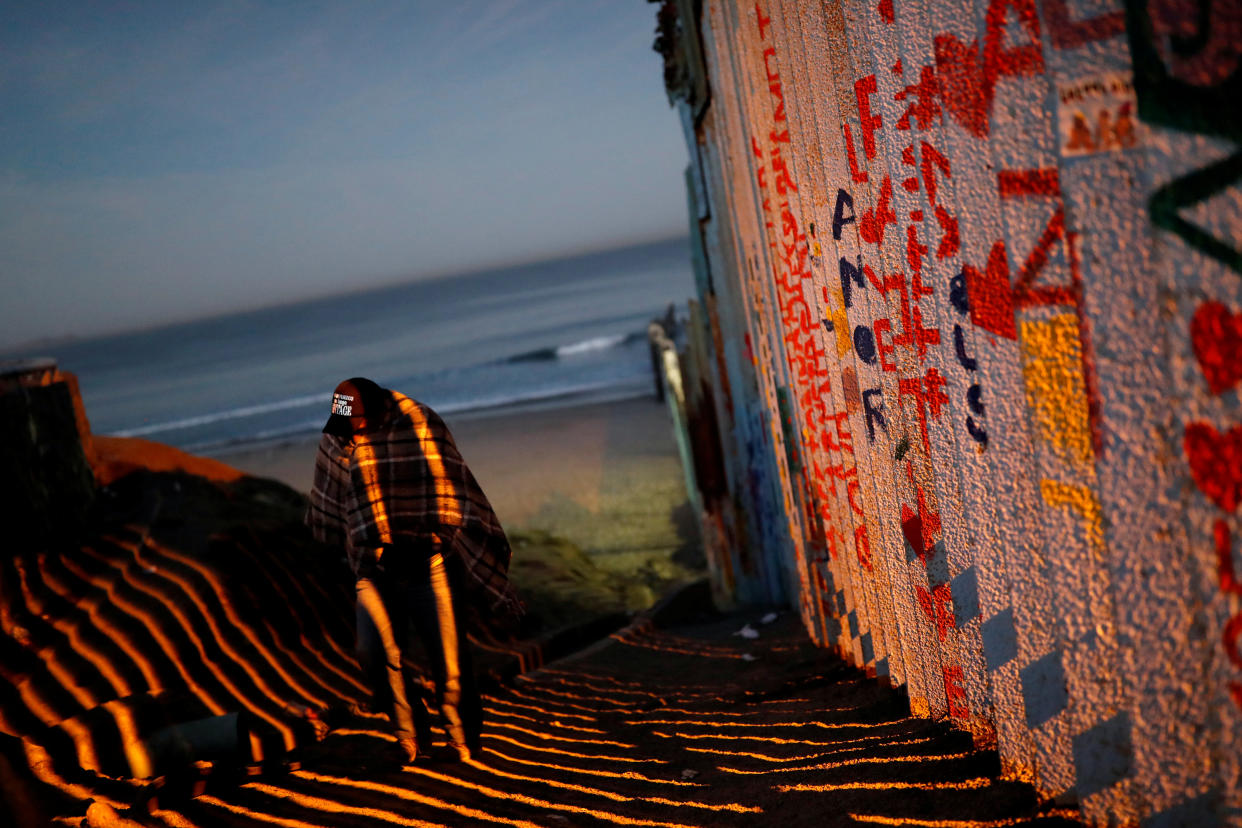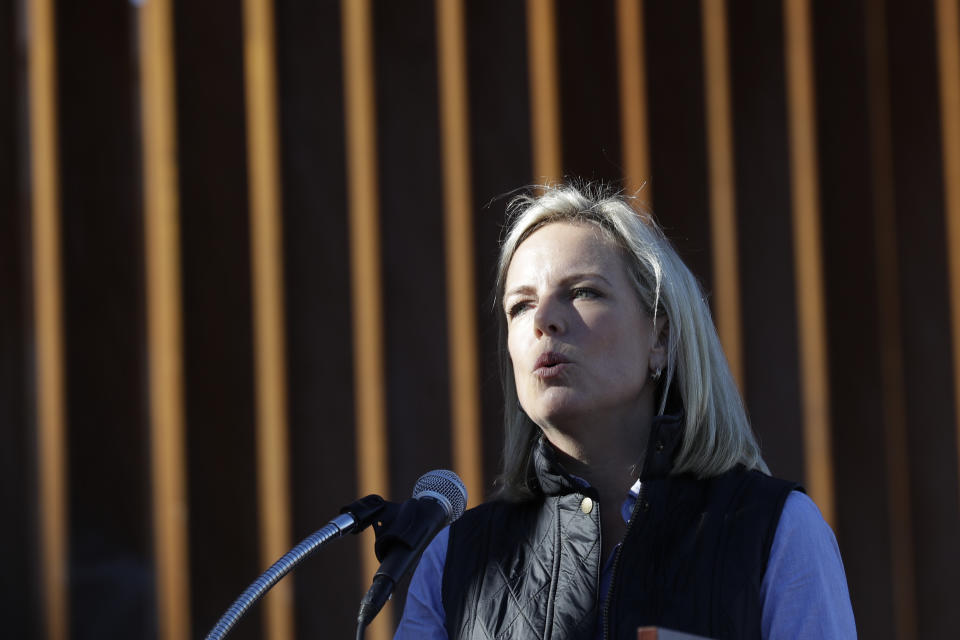Beyond the wall: The White House wish list for immigration funding

Ahead of President Trump’s primetime Oval Office address Tuesday, the White House issued a press release outlining a variety of additional funding demands from Congress, to address what Trump has described as a “the security and humanitarian crises” on the United States’ southern border.
The new proposals reflected requests outlined in a letter to lawmakers by Acting Office of Management and Budget Director Russell Vought following negotiations over the weekend. In addition to $5.7 billion Trump has requested for the construction of a steel barrier along 234 unspecified miles of the southwest border, the request calls for billions of dollars in additional funding for a variety of border-related projects, including expanding immigration detention facilities to their largest-ever capacity and new inspection technology to “deter and detect narcotics, weapons, and other materials that pose a threat to the United States.”
The White House email presents the additional funds as necessary to secure what President Trump and administration officials insist is a border “overwhelmed with illegal immigration, gang violence, crime, drugs, and human trafficking.”
In fact, after reaching a record low during Trump’s first year in office, illegal immigration across the border with Mexico returned to 2016 levels last year. Border states report no big surge in crime, and most illegal drugs, by far, are smuggled into the country by air, sea, tunnels or hidden in cars and trucks at official ports of entry.
Yahoo News spoke to various immigration advocates and border policy experts about the latest requests. Some of the proposals were well-received, such as “$800 million to fund enhanced medical support, transportation, consumable supplies, and additional temporary facilities necessary to ensure the well-being of those taken into custody,” programs that promise to further crack down on weapons and narcotics smuggling, and Trump’s willingness to “work with Congress to facilitate expanded in-country processing of refugee claims.” Others, like the request for record number of detention beds and a surge in immigration enforcement agents, elicited reactions ranging from suspicion to concern to outrage.
The consensus was that the request showed how the Trump administration’s own policies have resulted in a manufactured crisis on the border, raising questions about the justification for its new spending demands.
“Nothing in here is necessary to solve the border crisis created by the president’s bad policies,” said Alex Nowrasteh, a senior immigration policy analyst at the Cato Institute, a libertarian think tank.
Nowrasteh singled out as one example the request for $211 million to hire 750 additional Border Patrol agents. He dismissed assertions by CBP officials that agents on the ground are understaffed and overwhelmed by the situation at the border. While the numbers of children and families presenting themselves at southwest border have been on the rise, overall apprehension numbers remain at historic lows.
“Every government agency in history has claimed they’re short-staffed,” said Nowrasteh.
“The reason why these agents are so busy right now is because the Trump administration is requiring them to work with the rest of government to vet these people to an insane degree when they ask for asylum, make them stay on other side of border in Mexico for weeks or months, and have to house them, according to administration’s policy, in detention facilities for long periods of time. The administration has given them more work to do, even though the numbers are totally manageable,” he concluded.

Some policy experts endorsed the White House call for at least $563 million for 75 additional Immigration judges and support staff, to reduce the backlog of pending immigration cases, acknowledging that the result may ultimately be to more quickly facilitate more deportations. Nowrasteh and Randy Capps, director of research for U.S. programs at the Migration Policy Institute, said hiring additional immigration judges and support staff would help clear the backlog of over 800,000 cases currently pending in immigration courts.
“The crisis that we have is not a border security crisis as much as it is an asylum system crisis, because it takes forever for people to have asylum claims adjudicated,” said MPI’s Capps. “A lot more needs to be done to resolve that, but hiring more immigration judges will help.”
But others, like Gregory Chen, director of government relations at the American Immigration Lawyers Association, and ACLU federal immigration policy counsel Madhuri Grewal, criticized the request for more funds for immigration judges as disingenuous, citing a variety of actions the administration has taken — particularly under the direction of former Attorney General Jeff Sessions — to restrict immigration judges’ discretion on their dockets and, they suspect, hamper the court’s efficiency.
According to immigration data collected by Syracuse’s Transactional Records Clearing House, or TRAC, the immigration court backlog nearly doubled within the first year of Trump’s presidency and has continued to grow in the initial months of fiscal year 2019. Chen added that the immigration court backlog has been exacerbated by the partial government shutdown, with the Justice Department canceling all scheduled court hearings for non-detained individuals, who make up the vast majority of people in immigration court.
“Immigration court is a fundamental, critical aspect of the [immigration] process … and the administration has shut it down,” said Chen. “The fact that the administration is asking for more funds [for immigration court] illuminates the hypocrisy of its overall requests for a border wall and this additional funding.”
The items on the White House wish list that raised the greatest concern were those that didn’t appear to be directly connected to border security at all: “$571 million for 2,000 additional Immigration and Customs Enforcement personnel to enforce immigration laws, combat gang violence, catch drug smugglers and stop human traffickers” and “$4.2 billion to increase immigration detention capacity inside the U.S. to a record 52,000 beds.”

“This administration has continued to increase use of detention in thousands of cases, when it has been demonstrated that detention not necessary,” said Chen, criticizing the administration’s “unbridled willingness” to use detention as a deterrent for migrants, including those with legitimate asylum claims.
“There’s no reason that this administration needs to be seeking this incredibly high level of funding for 52,000 detention beds,” said the ACLU’s Grewal. “On any given day, 52,000 immigrants should not be in detention.” She argued that increasing detention only serves to increase deportation numbers and to “feed into the narrative that we have to lock them up.”
Capps pointed out that both the 2,000 additional ICE agents and 52,000-bed detention capacity have previously been part of the president’s annual budget requests and, even under a Republican- controlled Congress, they have been denied.
“It’s like he shoehorned them into the request,” said Capps, suggesting that the president is now trying “to force Congress to approve things they wouldn’t support before.”
“This is extortion,” said Simon Rosenberg, a longtime Democratic strategist and founder of the New Democratic Network, a progressive Washington think tank. Rosenberg argued that, regardless of the details, what’s most outrageous is the method by which Trump is making these requests.
“He knows what he wants to do is never going to pass Congress, so he’s creating a mechanism to go around Congress, which is this government shutdown,” said Rosenberg.
“What is missing from the president’s demands is any kind of justification that any of this is actually needed,” he continued. The administration, he argued, despite its repeated claims that there is an immigration crisis, has yet to provide reliable evidence “that the border is weaker than it was a year ago … no data to show a massive increase in the flow of narcotics, no data showing a massive increase of people coming over the border.”
Read more from Yahoo News:



